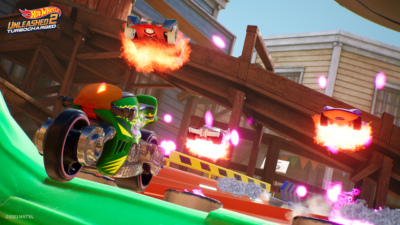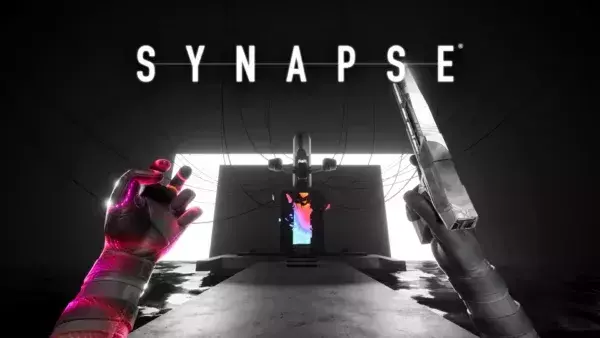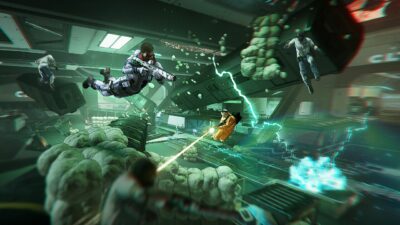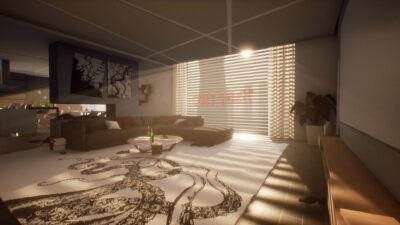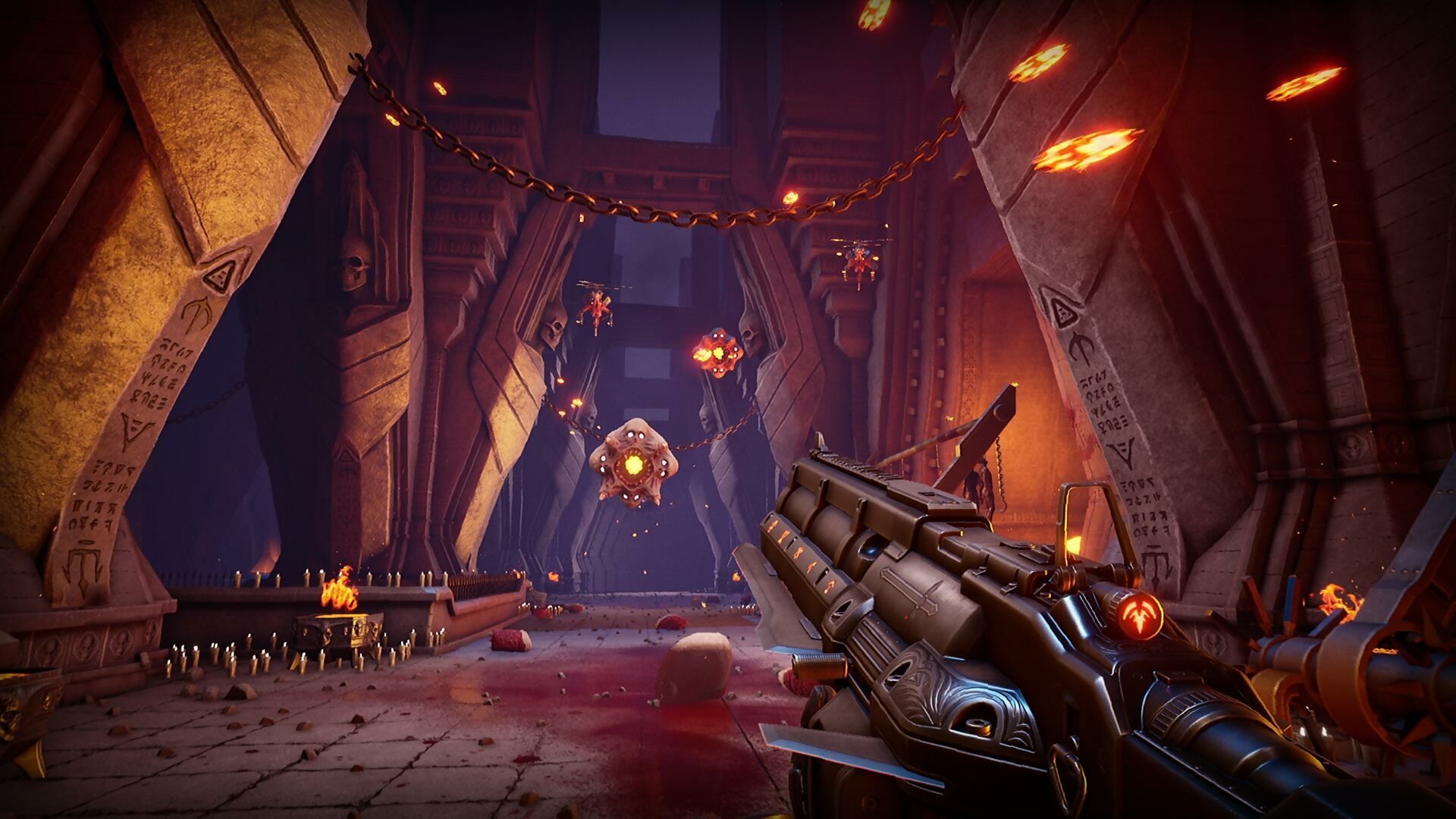
Just as Housemarque’s Returnal fused the third-person roguelike with the danmaku shoot-‘em-up genre to award-winning effect, so Scottish studio Damage State’s upcoming SCATHE aims to take players to its own particular plane of bullet hell. Trapped in an infernal labyrinth, you’re confronted by an army of grotesque and deadly enemies – many of them capable of firing complex waves of fiery projectiles.
Look at SCATHE in still images, and you’ll likely think of recent entries in the DOOM series, but programmer and Damage State co-founder Chris Dawson argues that his game’s mix of non-linear level design, drop-in, drop-out co-op, and its enemies’ aggressive attack patterns make it a markedly different kind of shooter. “Once people play SCATHE, they realise the stark differences,” Dawson tells us. “We’ve taken a blend of FPS games and twisted them to make something we wanted… Dodging streams of bullets and having to consider your route of attack with the intensity of everything was greatly appealing.”
Given how slick and polished SCATHE looks, it’s doubly impressive that it’s the product of such a tiny studio. The team comprises just three people: Dawson on the aforementioned programming duties, art director and co-founder Tim Hay, and character artist Manu Lopez. With several years of games industry experience already behind them, the trio got together in 2019 with the express intention of creating something uniquely their own. “Although we worked in the same vicinity and on similar games – everything from mobile to triple-A – it was only a few years before starting up that we met one another,” Dawson explains. “We were fed up with games companies falling into similar patterns of failure and maybe lasting only a few years – then we’d be forced to relocate. We wanted to create a studio with a modern approach and one that learns from everything we have experienced – both good and bad!”

All weapons have a secondary function, like the Hell Hammer’s rocket launcher, which is designed to reduce the amount of time players spend switching between guns.
After one of Damage State’s artists came up with an early sketch of a demonic entity called a Splitter, Dawson then came up with the idea of making a shooter set in hell – and at this point, SCATHE was born. And from those very early stages, it was planned as an action-focused shooter without the added trimmings and bloat you commonly see in modern games of its type – you won’t find crafting or levelling, and the pace won’t grind to a halt because of a fiddly environmental puzzle. Even the controls are designed to be streamlined.
Says Dawson: “Everything in SCATHE – like buttons – can be triggered by shooting, removing the need for ‘Press E to interact’ prompts, which is commonly the case. For example, there are moving platforms and pillars that you can trigger, perfect jumps to make, secret doors, and rotating bridges, amongst others. It’s a great balance between discovery and action. We tried out more advanced puzzles and multi-trigger buttons early on in development, but they just didn’t fit the game at all.”
Another design choice that sets SCATHE apart is its array of exotic weapons. Where most shooters start you out with a feeble pistol of some sort, SCATHE immediately gives you the Hell Hammer: a gigantic bit of ordnance capable of firing shotgun-like blasts, while pressing the secondary fire button will set off its rocket launcher. SCATHE’s other weapons are equally big and brash, and all designed to make you feel like a powerful denizen of the underworld – something that makes balancing the game’s challenge, well… challenging, Dawson admits. “There are so many factors in SCATHE to think about, from obvious ones like movement speed to more obscure things like lighting levels for clarity. You want to create a fast and intense experience so the player feels like a powerful, unstoppable boss, but you can’t let them smash through the game without challenge. Even things like jumping are a challenge, as you need to jump bullets coming towards you or get out of a sticky situation, but you can’t jump over certain parts of the map, like barriers and rocks. If you change one, you break another.”

SCATHE’s hellish maze is broken up into small, discrete areas with multiple exits, making encounters short and snappy while offering varied paths through the game.
Rather than make SCATHE more difficult by having its enemies absorb dozens of bullets (“That’s a really poor way of doing it,” Dawson notes), the game will instead focus on how much damage the player can take before they finally keel over, how many demons spawn in a particular area, and how fast their bullets are. “Making sure the game sits as challenging but not unfair is the focus,” we’re told.
Besides, if the journey through hell becomes a bit too hard-going, the player can rope in up to three friends to help them. There are no plans to add any competitive modes at present, and neither is there friendly fire – the latter was tried out earlier in development, but had a detrimental effect on the gameplay. As it now stands, “the drop-in, drop-out multiplayer works quite neatly,” says Dawson. “When a player creates a game or loads their last location, they can choose whether to play alone, allow friends – a private game – or allow anyone. Players who want to join will either join a friend or hit ‘quickplay’. Regardless of where the host player is, the player drops in right next to them and joins the play. If they want to leave, they just quit and can come back in whenever they like.”
DEMON SEED
Damage State has put a lot of creative energy into conjuring up as many hideous demons as it could for SCATHE. But while you might think that setting a game in hell would give an artist free licence to come up with all kinds of grotesque critters, it’s a location that also poses a problem: so many other games have sunk to the same infernal depths, it’s quite hard to dream up monsters that players won’t have seen a dozen times before. “It can be really difficult to create something fresh,” says Dawson. “Without a doubt, clichéd enemies like zombies are always present in these types of games in various forms, but they’re heavily used for good reason. We use this fact to force ourselves to be more novel, and SCATHE features some unique demons – ‘Fleshies’ spring to mind; they’re bouncing, erratic balls of flesh and metal. They can be a nightmare due to their unpredictability… another one is the ‘Prism’, a floating, triangular demon that spawns lasers from its multiple eyes, burning the player and even other demons. I won’t go through all the others, but there’s a nice mix of fresh takes on what’s expected and novel ideas that make up the enemies of SCATHE.”

Enemies’ rapid firing rate makes SCATHE’s combat quite different from most other modern shooters: you’ll spend more time dodging, weaving, and trying to eliminate them from a distance.
At a time when action games are becoming ever-more weighed down with features and busywork, it’s refreshing to see SCATHE looming on the horizon: an FPS that mixes the complex level designs and freedom of movement of a modern shooter with the bullet-dodging adrenaline surge of an arcade title by the likes of CAVE or Treasure. SCATHE is, if anything, a reaction to the type of FPSs Dawson and his team have played – and, by the sounds of things, tutted at – in recent years. “We were bored of linear games,” says Dawson. “The FPS market is dominated by linear paths, and with SCATHE, we wanted to create choice. Thus the idea of ‘escape the maze’ was born. Having lots of zones connected by various doors, so you could pick your path and discover everything at your own pace, appealed to us. It also ticked another box that the game saved between zones, thus allowing for five-to-ten-minute bites of play – or you can play for a solid five hours straight.”
A MAZE OF DEATH
The goal in SCATHE is simple to grasp – enter a zone, kill every evil being you see, then find one of several exits – but it’s the multiple routes that keep the game interesting, Dawson says. “Every zone connects to another and makes up the larger maze. It means players are free to pick their path and create their own journey. In addition to this, each zone is handcrafted as we wanted to avoid procedural generation and make something that players can learn and even jot down their best route.”


